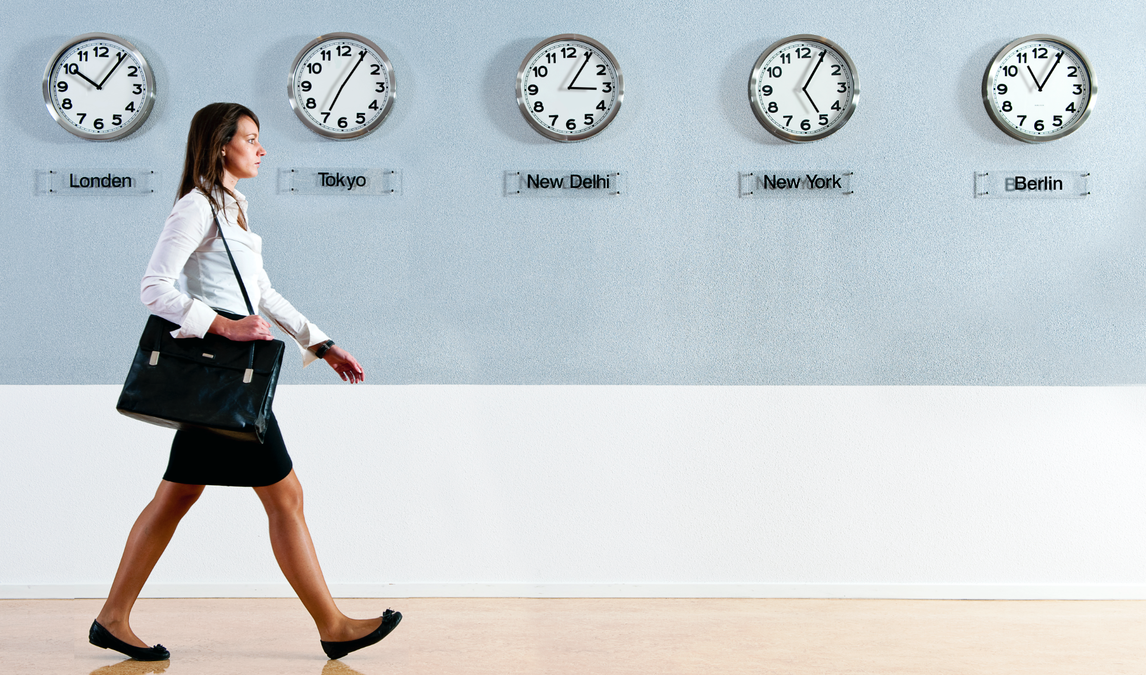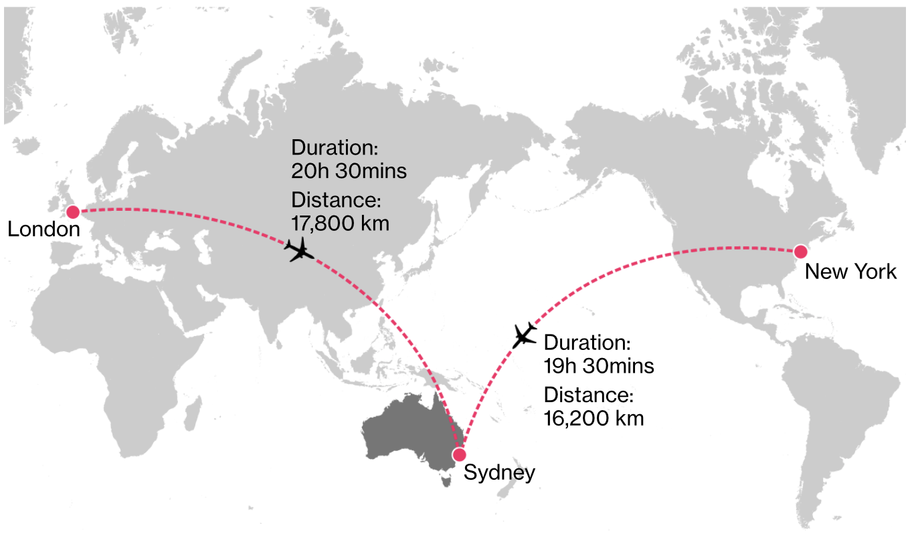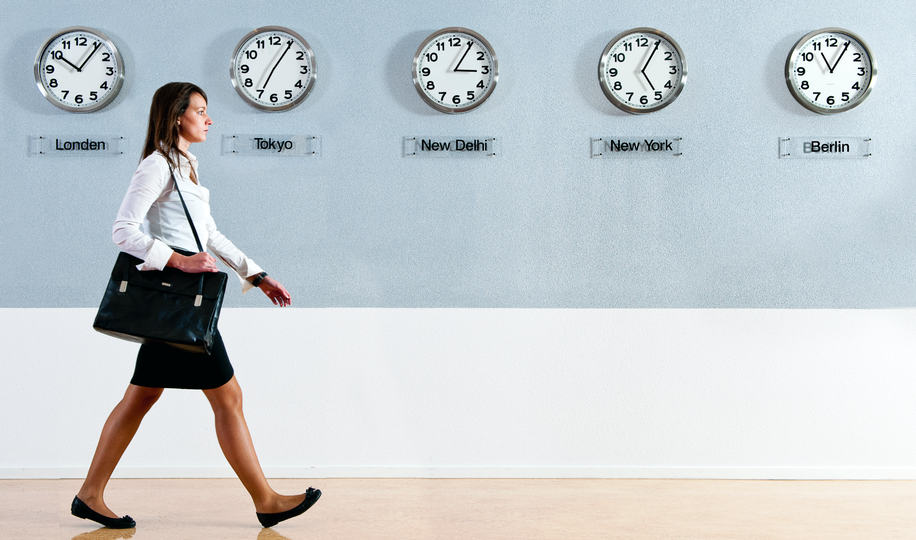Qantas' non-stop New York-Sydney flights will also be a 'jetlag lab'
Qantas' trials of non-stop New York-Sydney flights puts a new focus on the physical toll of an ultra-long journey.

For decades, travelers have stoically endured jetlag as an unavoidable menace on long journeys. Now, as airlines push for record-breaking non-stop flights halfway around the planet, efforts to counter the debilitating symptoms are turning into a billion-dollar industry.
Fresh insight into the physical and emotional toll of ultra-long haul travel should emerge this weekend when Qantas flies direct from New York to Sydney. No airline has ever completed that route without stopping. At nearly 20 hours, it’s set to be the world’s longest flight, leaving the U.S. on Friday and landing in Australia on Sunday morning.
This will be more than an endurance exercise. Scientists and medical researchers in the cabin will turn Qantas’s brand-new Boeing 787-9 Dreamliner into a high-altitude laboratory. They’ll screen the brains of the pilots for alertness, while monitoring the food, sleep and activity of the few dozen passengers, including selected media, to see how humans hold up to the ordeal.
The proliferation of super-long flights – Singapore Airlines resumed non-stop services to New York last year – is partly driven by the development of lighter, more aerodynamic aircraft that can fly further.
Jetlag-busters
The physical burden on customers is putting a renewed focus on jetlag, and creating a supermarket of products and home-made creations to ease the suffering. In that shopping basket: melatonin tablets, Pfizer's anti-anxiety medication Xanax, and Propeaq light-emitting glasses that claim to get the body back on track. And yes, there’s an app for that and many other potential remedies.
Timeshifter (US$36.99 per year) creates personalized anti-jetlag plans telling you when to seek or avoid sunlight, caffeine or sleep, based on the destination. Uplift (US$19.99 per year) generates a self-administered, five-minute acupressure plan according to your new time zone. ByeByeJetLag (US$7.99) plays a 15-minute, in-flight “audio guide” to set your body clock to the destination, while the free Entrain tells you one thing before your trip: when to seek and avoid sunlight.
The potential customer base is staggering. The International Air Transport Association expects some 4.6 billion people to take a flight in 2019, a total that will jump to 8.2 billion in 2037.
Demand for jet-lag therapies is growing at about 6% each year and the industry will be worth US$732 million in 2023, according to BIS Healthcare. The broader sleeping-disorder market – dominated by pills – is worth US$1.5 billion and will swell to US$1.7 billion by 2023, GlobalData says, adding that more than 80 drugs targeting disturbed sleep are in clinical development.
Timezone hopscotch
Jetlag typically strikes when a traveler crosses three times zones or more in quick order, leaving the body’s internal clock running to the timetable at home. The chief complaint after touching down is often overwhelming fatigue during the day or merciless insomnia at night. The fallout can be worse heading east, because traveling in that direction effectively reverses the normal day-and-night cycle.
Unsettling as they are, those ailments barely do jetlag justice.
Each of the billions of cells in the human body has its own clock, and vital processes including heart function, food absorption and metabolism are all disrupted when organs get out of step, said Carrie Partch, a biochemist and associate professor at the University of California Santa Cruz who has studied the circadian rhythm for 20 years.
“Jetlag is more than just an inconvenience,” Partch said in an interview. “It’s pretty devastating physiologically. If you’re a constant traveler, you’ll probably put on more weight, you’ll probably have cardiovascular challenges and you may have some behavioral changes.”
While researchers in this field understand how light enters the brain and adjusts the master clock, they’re still learning more. As recently as 2017, scientists won a Nobel prize for discovering molecular mechanisms that control circadian rhythms. Even if the core proteins of a rodent can be manipulated in a laboratory to speed up internal clock adjustment, a fast-acting pill that can do the same for frequent flyers is a way off, Partch said.
Scientists have found exercise and the right food can help synchronize the body to a new time zone, though research has also repeatedly shown sunlight is the most powerful tool. A University of Boulder Colorado study in 2017 said body-clock adjustment can be rapidly achieved by exposure to natural light alone.
Friday’s flight from New York, and another from London later this year, are key tests for Qantas as it prepares to start direct commercial services from those cities to Sydney as soon as 2022. The airline calls it Project Sunrise. If successful, Qantas says other super-long, non-stop routes from Australia’s east coast to South America and Africa might follow.
Airbus and Boeing are vying to supply the carrier with new long-range aircraft that can reach the destination with a full load and fuel to spare. Qantas plans to make a decision to press ahead with these flights, or ditch the idea, by the end of 2019.


American Airlines - AAdvantage
02 Jun 2019
Total posts 20
Could the 787-9 do JFK to Sydney nonstop if it was only J class and Y + ? The passenger seeking a bargain should fly via LAX.
24 Aug 2011
Total posts 1207
Unlikely it could do it with anything approaching a profitable load.
03 May 2013
Total posts 680
Unless its an Airbus I won't be sitting on any Boeing that long.
Qantas - Qantas Frequent Flyer
14 Sep 2012
Total posts 382
Seriously, Wouldn't they both fly the same way for the same amount of time with the same seats, same food, same service, same pilots? Where is the difference?
Qantas - Qantas Frequent Flyer
06 Oct 2016
Total posts 175
I believe the reference is to the customer experience (sound, cabin pressure, lighting and general "comfort"), not the ability of the machine, the 350 is superior to the 787 in those departments.
Qantas - Qantas Frequent Flyer
06 Oct 2016
Total posts 175
I've said it before, but Q need a couple of punter with 2 bottles of wine under their belt to get a reasonable demographic!!!
Not happening with the staff and press on the test
Qantas
22 Oct 2012
Total posts 319
I hope that on this test flight that the selected passengers will be spread fairly across the cabins, with a couple of rows in Y being full.
Qantas - Qantas Frequent Flyer
09 Feb 2015
Total posts 388
I don't think I would want to do 20 hours in one leg, regardless of class. Unless you are that pressed for time, there is often many benefits and feel good factors with a stopover in Singapore/HK for example.
14 Oct 2016
Total posts 112
I'd say the most important aspect is to properly test the economy class. Singapore Airlines flies the SIN to EWR route daily with no issues in the business and premium economy.
As sunrise flights will be a bit more premium, Qantas needs to improve their economy seat up to a Y+ or JAL standard with at least 33"-34" inches of pitch. Premium should also be up'ed to 40"-42",so that the economy seat does not eat away at it. Business and first should be OK as they will still offer a flat bed, which is still quite a substantial difference.
Extra space for this enhanced economy and premium can be made by moving their lavatories to the lower deck.
Qantas - Qantas Frequent Flyer
30 May 2013
Total posts 381
Unless they squeeze the economy passengers into rows where everyone's sitting next to each other for 20 hours, this whole thing will be seen as nothing more than a publicity stunt. They need to make sure the seat in front of each person is fully reclined too. This is the reality of ultra long-haul for most people.
24 Aug 2011
Total posts 1207
There are only 40 pax on this flight. Y will be completely empty. It is more a publicity item than anything else which Qantas do very well and it will achieve what they are after which is publicity in both AU and US.
There is no statistical value in a sample of 2 flights particularly as the crew will not be backing up to do the same distance again 48 hours later.
14 Oct 2016
Total posts 112
Yeah if they don't put a solid crowd in the economy section for the entire flight, i'll consider these publicity flights. They could always book a few tickets on SQs EWR to SIN service and monitor the passengers, but you wont get the publicity from this.
KLM - Flying Blue
05 Feb 2019
Total posts 36
"...Scientists and medical researchers in the cabin will turn Qantas's brand-new Boeing 787-9 Dreamliner into a high-altitude laboratory..."
I am glad to read that Qantas is going to do this research
This is a very important matter for all passengers
03 May 2013
Total posts 680
When you've flown on an A380 and a B777 on an ultra long haul....come back to me. Until then take my word for it; Airbus reigns supreme for passenger experience.
QFF
16 May 2016
Total posts 66
If I'm up the front I miiiiight consider a flight of this length. Economy no chance. Economy with the kids in tow (vomits at thought!). I go to the US in Business class quite a few times a year, so very comfortable. But even then, I'm getting REALLY edgy after about 12 hours.
22 Sep 2017
Total posts 94
Given that sunlight is the best cure, it would be good to have a coordinated windows-shades-open periods designed to minimise jetlag.
Unfortunately this will be resisted by passengers who want to watch IFE in the dark, cabin crew who want everybody asleep to minimise their workload, etc.
Qantas - Qantas Frequent Flyer
09 Jun 2011
Total posts 88
... and when flying at night, which is when I expect (but don't know) the JFK-SYD and SYD-LHR flights will operate.
23 Sep 2015
Total posts 49
-ZNJ is just about ready to ship out from Boeing so maybe they'll use that as the testbed?
16 Sep 2019
Total posts 2
I think this was the plan
Qantas - Qantas Frequent Flyer
21 Nov 2012
Total posts 3
Frankly I have found it excessively tiring on the Perth to London service. My next flight to London will be the longer way with the A380, in my opinion the best ever aircraft for long flights. What is needed is larger, not smaller aircraft!
09 May 2017
Total posts 36
We have done both on a regular basis and the noise is lower on the A380, there is more space and we get off fresher.
QF
04 Apr 2014
Total posts 209
100%. I'm always fresher after a long flight on a 380 than a twin, even the latest 350/787's.
Qantas - Qantas Frequent Flyer - Chairmans Lounge
01 Sep 2011
Total posts 416
I would love to be on those test flights. Just putting it out there. LOL.
01 Nov 2018
Total posts 81
Quite surprised up till now that Qantas hasn't ordered any Airbus A350 for their long haul flights like what Singapore Airlines has, suppose we have a good buddy deal with the USA
Emirates Airlines - Skywards
19 Jul 2014
Total posts 27
Having done a lot of long haul, I find the A350 far superior to the 787, which is way noisier and cramped, neither come up to the comfort of the 380. 20 hours in nine abreast comedy class with a seat pitch of 31, would require some special drugs.
01 Nov 2018
Total posts 81
Well looks like Airbus A350-1000 is also set for Qantas sunrise project. And Airbus have reckoned they've got the answer to Boeing's Dreamliner
15 Oct 2019
Total posts 9
Only when those from management have flown the full distance from Sydney in rows 52 - 54 seat E in each or any of them and experienced the horror of that position for 16+ hours will I believe the Boeing 787 is anything but a 'scream liner'. Having flown in each cabin (but never as far back as the 50s rows), it's the first time I've experienced any jet lag. Living in Brisbane we passengers have no choice, if flying with Qantas, to use the 787 scream liner to north America, via Los Angeles. Forward from there it'll be American Airlines.
CX
05 Jun 2012
Total posts 127
I'm a bit confused by a couple of things in the article. First it says that New York to Sydney is set to be the world's longest flight at 20 hours, then it shows a graphic saying that New York-Sydney is 19h30m and 16,200km but London-Sydney is 20h30, and 17,800km. Since I believe neither route has officially been launched I am not sure how anyone can claim that London-New York is set to be the world's longest flight given that QANTAS is contemplating both. Perhaps I missed something???
I am also a little confused by the other issue that comes from the quoted statistics. Both are true long-haul flights so I think we can discount the the "slower speeds" during take-off and landing and assume that the extra flight time is accounted for by the extra distance - which means that the London flight will take just one extra hour to fly an extra 1,600km. Or, to put it another way, doing the extra distance/time at 1,000mph - well over the speed of sound or, more realistically, averaged over, say, 18 hours of the flight at an additional average speed of 56mph which would mean an exponential increase in fuel burn (see research here) - unless, of course, it is addressed by tailwinds, but wouldn't that be offset by headwinds in the opposite direction? I am no expert on these matters so would be interested to hear where my thinking is going awry!
Hi Guest, join in the discussion on Qantas' non-stop New York-Sydney flights will also be a 'jetlag lab'